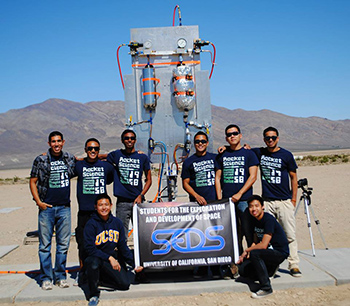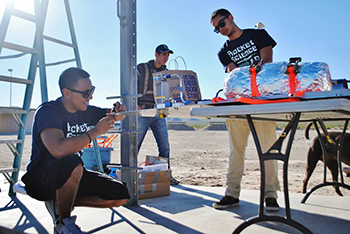Acting Student and Bioengineering Alumna Awarded Soros Fellowship for New Americans
Awards & Accolades
By:
Published Date
By:
Share This:

On a hot Saturday afternoon in the Mojave Desert, a team of UC San Diego engineering students huddled in a small underground bunker and watched quietly as the rocket engine they had designed over the past eight months flared to life on a test platform. As a jet of rocket fuel sprang out of the engine at supersonic speed, the students cheered loudly.
The test by the UC San Diego chapter of Students for the Exploration and Development of Space (SEDS) marked the first time that a university-led group had successfully designed, built and tested a 3-D-printed rocket engine, according to Space.com.
“It was an amazing feeling,” said Deepak Atyam, the team’s leader and president of SEDS. “We could all feel the power of the engine in the bunker. It’s something you can’t really describe.”
The successful test represented an important step in demonstrating that 3-D printing is a viable manufacturing method for rocket engines, said Forman Williams, a professor at the Jacobs School of Engineering and the students’ advisor. Williams admits that he was skeptical at first; the design of liquid-propellant rockets is very complex and detailed. But Williams said the students surprised him.
"I was greatly impressed with the success of the test firing,” he said. “Our undergraduate team did a superb job."
NASA and private groups have been investigating how to use 3-D printing to reduce the cost and design constraints of manufacturing complicated rocket parts. The space agency recently set a first by testing a 3-D-printed rocket fuel injector. The UC San Diego student team went a step further, however, by designing a whole engine that was then manufactured on a specialty 3-D printer by Illinois-based GPI Prototype and Manufacturing Services. The engine was primarily financed by NASA’s Marshall Space Flight Center in Huntsville, Ala. Students also worked closely with Carlsbad-based Flometrics.

Designing, building and testing the engine provided students with invaluable experiences, Atyam said. “We put almost every single theory we studied into the engine we designed,” he said.
Andy Kieatiwong, a sophomore and aerospace engineering major from Las Vegas, said he chose to attend UC San Diego because he knew he could get great hands-on learning experiences on campus. Working on the rocket engine was a dream come true, he said. “It’s amazing,” he said. “It really helped me realize why I picked this major.”
Kieatiwong is in charge of introducing a new generation of engineering students to rocket science. This fall and spring, he will lead about a dozen of them as they add more sensors to the testing rig and engine. The plan is to go back to the Mojave and gather more data in February. The students also plan to design, print and test an engine for a bigger rocket. The ultimate goal is to launch the rocket up to 100,000 feet.
Working on the project kept students motivated to make it through their demanding classes. “We’re doing all this class work not for its own sake; we need the knowledge to make our engine better,” said Jin Oh, a fifth-year aerospace major. Students spend a lot of time and effort on the project, Oh said, including 10 to 15 hours every weekend.
Atyam started the project a year ago, when he was an intern at NASA’s Marshall Space Flight Center. Back at UC San Diego, he and fellow aerospace engineering majors founded a chapter of Students for the Exploration and Development of Space here on campus. They spent three months familiarizing themselves with the complex theory behind the design of rocket engines. Then, they spent the next five months creating their design and optimizing it for 3-D printing. The process wasn’t always smooth, as the students’ design stretched 3-D printing’s capabilities to the limit. It took almost four days to print the engine.
Finally, they drove out to the Mojave on the eve of the test and camped out in the desert. They awoke and started setting up for the test around 7:30 a.m. at a site maintained by the Friends of Amateur Rocketry. Five hours later, the testing rig and the engine were finally in place. The students retreated to an underground bunker—a standard safety measure.
Atyam was in charge of the valves that were controlling the flow of fuel to the engine. It took a while for the realization that the test was successful to sink in, he said. Then, everyone started congratulating each other, and they celebrated with a barbecue.
The engine was designed to power the third stage of a rocket carrying several NanoSat-style satellites with a mass of less than a few pounds each. It is about 7 inches long and weighs about 10 pounds. Designed to generate 200 pounds of thrust, the engine is made of cobalt and chromium, a high-grade alloy. It runs on kerosene and liquid oxygen and cost about $6,800 to manufacture, including $5,000 from NASA. The students raised the rest of the money through barbecue sales and other student-run fundraisers.
“I feel that this is something that can revolutionize this industry,” Atyam said.
Share This:
Keep up with all the latest from UC San Diego. Subscribe to the newsletter today.